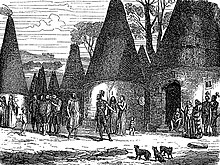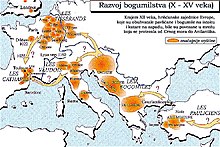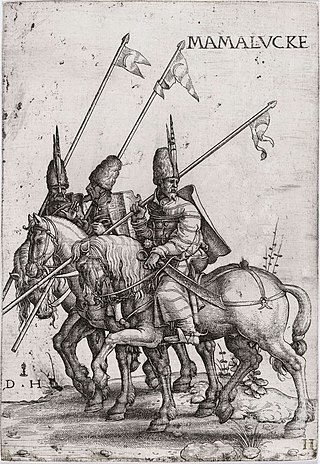
Mamluk or Mamaluk were non-Arab, ethnically diverse enslaved mercenaries, slave-soldiers, and freed slaves who were assigned high-ranking military and administrative duties, serving the ruling Arab and Ottoman dynasties in the Muslim world.

The Swedish slave trade mainly occurred in the early history of Sweden when the trade of thralls was one of the pillars of the Norse economy. During the raids, the Vikings often captured and enslaved militarily weaker peoples they encountered, but took the most slaves in raids of the British Isles, and Slavs in Eastern Europe. This slave trade lasted from the 8th through the 11th centuries. Slavery itself was abolished in Sweden in 1335.

Saqaliba is a term used in medieval Arabic sources to refer to Slavs, and other peoples of Central, Southern, and Eastern Europe. The term originates from the Middle Greek slavos/sklavenos (Slav), which in Hispano-Arabic came to designate first Slavic slaves and then, similarly to the semantic development of the term in other West-European languages, foreign slaves in general.

Slavery in medieval Europe was widespread. Europe and North Africa were part of a highly interconnected trade network across the Mediterranean Sea, and this included slave trading. During the medieval period (500–1500), wartime captives were commonly forced into slavery. As European kingdoms transitioned to feudal societies, a different legal category of unfree persons -- serfdom—began to replace slavery as the main economic and agricultural engine. Throughout medieval Europe, the perspectives and societal roles of enslaved peoples differed greatly, from some being restricted to agricultural labor to others being positioned as trusted political advisors.
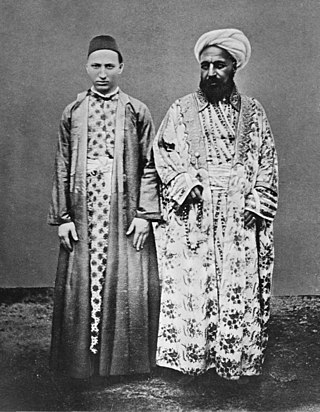
White slavery refers to the enslavement of any of the world's European ethnic groups throughout human history, whether perpetrated by non-Europeans or by other Europeans. Slavery in ancient Rome was frequently dependent on a person's socio-economic status and national affiliation, and thus included European slaves. It was also common for European people to be enslaved and traded in the Muslim world; European women, in particular, were highly sought-after to be concubines in the harems of many Muslim rulers. Examples of such slavery conducted in Islamic empires include the Arab slave trade, the Barbary slave trade, and the Black Sea slave trade, among others. It was common for Europeans to be traded alongside Africans, Turks, Iranians, and sometimes other Arabs.

In the Middle Ages, the Volga trade route connected Northern Europe and Northwestern Russia with the Caspian Sea and the Sasanian Empire, via the Volga River. The Rus used this route to trade with Muslim countries on the southern shores of the Caspian Sea, sometimes penetrating as far as Baghdad. The powerful Volga Bulgars formed a seminomadic confederation and traded through the Volga river with Viking people of Rus' and Scandinavia and with the southern Byzantine Empire Furthermore, Volga Bulgaria, with its two cities Bulgar and Suvar east of what is today Moscow, traded with Russians and the fur-selling Ugrians. Chess was introduced to Medieval Rus via the Caspian-Volga trade routes from Persia and Arabia.
A freedman or freedwoman is a formerly enslaved person who has been released from slavery, usually by legal means. Historically, slaves were freed by manumission, emancipation, or self-purchase. A fugitive slave is a person who escaped enslavement by fleeing.
A significant number of people in the former Kingdom of Bosnia converted to Islam after the conquest by the Ottoman Empire in the second half of the 15th century, giving it a unique character within the Balkan region. It took over one hundred years for Islam to become the majority religion. Many scholars agree that the Islamization of the Bosnian population was not violent, but was, for the most part, peaceful and voluntary.
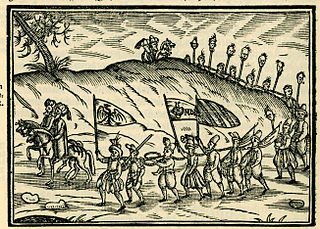
Slavery in the Ottoman Empire was a major institution and a significant part of the Ottoman Empire's economy and traditional society. The main sources of slaves were wars and politically organized enslavement expeditions in the Caucasus, Eastern Europe, Southern Europe, Southeast Europe, and Africa. It has been reported that the selling price of slaves decreased after large military operations. In Constantinople, the administrative and political center of the Ottoman Empire, about a fifth of the 16th- and 17th-century population consisted of slaves. Statistics of these centuries suggest that Istanbul's additional slave imports from the Black Sea slave trade have totaled around 2.5 million from 1453 to 1700.

The Danish slave trade occurred separately in two different periods: the trade in European slaves during the Viking Age, from the 8th to 10th century; and the Danish role in selling African slaves during the Atlantic slave trade, which commenced in 1733 and ended in 1807 when the abolition of slavery was announced. The location of the latter slave trade primarily occurred in the Danish West Indies where slaves were tasked with many different manual labour activities, primarily working on sugar plantations. The slave trade had many impacts that varied in their nature, with some more severe than others. After many years of slavery in the Danish West Indies, Christian VII decided to abolish slave trading.

Slavery in Spain can be traced to the Phoenician and Roman eras. In the 9th century the Muslim Moorish rulers and local Jewish merchants traded in Spanish and Eastern European Christian slaves. Spain began to trade slaves in the 15th century and this trade reached its peak in the 16th century. The history of Spanish enslavement of Africans began with Portuguese captains Antão Gonçalves and Nuno Tristão in 1441. The first large group of African slaves, made up of 235 slaves, came with Lançarote de Freitas three years later. In 1462, Portuguese slave traders began to operate in Seville, Spain. During the 1470s, Spanish merchants began to trade large numbers of slaves. Slaves were auctioned at market at a cathedral, and subsequently were transported to cities all over Imperial Spain. This led to the spread of Moorish, African, and Christian slavery in Spain. By the 16th century, 7.4 percent of the population in Seville, Spain were slaves. Many historians have concluded that Renaissance and early-modern Spain had the highest amount of African slaves in Europe.

The history of slavery in the Muslim world began with institutions inherited from pre-Islamic Arabia. The practices of keeping slaves in the Muslim world nevertheless developed in radically different ways in different Muslim states based on a range of social-political factors, as well as the more immediate economic and logistical considerations of the Arab slave trade. As a general principle, Islam encouraged the manumission of Muslim slaves as a way of expiating sins, and many early converts to Islam, such as Bilal, were former slaves. However, Islam never banned the practice, and it persisted as an important institution in the Muslim world through to the modern era.

The Black Sea slave trade trafficked people across the Black Sea from Europe and Caucasus to slavery in the Mediterranean and the Middle East. The Black Sea slave trade was a center of the slave trade between Europe and the rest of the world from antiquity until the 19th century. One of the major and most significant slave trades of the Black Sea region was the trade of the Crimean Khanate, known as the Crimean slave trade.

Ancillae (plural) were female house slaves in ancient Rome, as well as in Europe during the Middle Ages.

Slavery in Egypt existed up until the early 20th century. It differed from the previous slavery in ancient Egypt, being managed in accordance with Islamic law from the conquest of the Caliphate in the 7th century until the practice stopped in the early 20th-century, having been gradually abolished in the late 19th century. Slave trade was abolished successively between 1877 and 1884. Slavery itself was not abolished, but it gradually died out after the abolition of the slave trade, since no new slaves could be legally acquired. Existing slaves were noted as late as the 1930s.

Slavery in al-Andalus refers to the slavery in the Islamic states in Al-Andalus in the Iberian Peninsula in present day Spain and Portugal between the 8th-century and the 15th-century. This includes the Emirate of Córdoba (756–929), the Caliphate of Córdoba (929–1031), the Almoravid rule (1085–1145), Almohad rule (1147–1238) and the smaller Taifa principalities, notably the Emirate of Granada (1232–1492).

Slavery was a major part of society, culture and economy in the Abbasid Caliphate (750–1258), which during its history included most of the Middle East. While slavery was an important part also of the preceding Umayyad Caliphate (661–750), it was during the Abbasid Caliphate that the slave trade to the Muslim world reached a permanent industrial scale.

Bukhara slave trade refers to the slave trade in the city of Bukhara in Central Asia from antiquity until the 19th-century. Bukhara and Khiva were known as the major centers of slave trade in Central Asia for centuries, until the Russian conquest of Central Asia in the late 19th-century.

The Prague slave trade refers to the slave trade conducted between the Duchy of Bohemia and the Caliphate of Córdoba in Moorish al-Andalus in the early Middle Ages. The Duchy's capital of Prague was the center of this slave trade, and internationally known as one of the biggest centers of slave trade in Europe at the time.

The Venetian slave trade refers to the slave trade conducted by the Republic of Venice, primarily from the early to the late Middle Ages. The slave trade was a contributing factor to the early prosperity of the young Republic of Venice as a major trading empire in the Mediterranean Sea.

